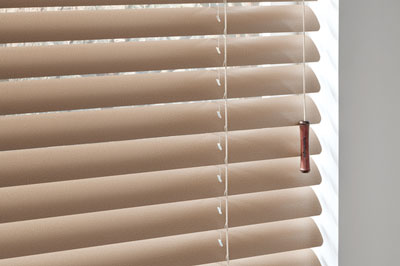Take a look at your window treatments. Are the slats bent? Is the fabric fraying? It may be time to update your window treatments. Most blinds have a lifespan of 7 or 8 years. After that, window treatments can start to show wear and tear. Here are five signs that it is time to change your blinds.
Discolored Blinds: No blinds are impervious to the sun’s UV rays. After years and years of constant exposure, blinds can appear stained and discolored. It is a sign of deterioration of the blind material, meaning they are close to breaking and not doing their job. The good news? Since you last purchased blinds, new technologies have been developed, offering more UV protection in blind materials and thus an even longer life span for your next purchase of window blinds.

Warped Slats: Faux wood and wood blinds can warp and curve over time, especially when exposed to humidity. The moisture in humid air causes the wood product to expand, which causes the warping. When this happens, it is time to change your blinds. Not only are warped blinds unpleasant to look at, they are not functioning properly.
Struggle to Raise: If your blinds are difficult to lower or raise, or, if they seem to stick in certain spots, it’s likely a problem with the lift mechanism. After years of wear and tear, the lift mechanism can break down. If the blinds were not installed or measured properly to your windows, you may experience these same struggles when trying to life and raise your window blinds. This is a safety issue: your blinds are at risk of falling from the window, especially if pulled too hard.
Slat Gaps: If your blind slats no longer close tightly, or some of the slats do not close at all, it is probably time to change your blinds. Not only is this an eye sore, it also means the blinds are no longer doing their job. Sometimes, replacing the tilt wand can be enough to correct this problem.

Cords on Blinds: Many people are unaware that corded blinds have been discontinued from mass production in the US. The U.S. Consumer Product Safety Commission (CPSC) determined that the way to make the most significant and immediate impact on reducing the strangulation risk to young children and pets from window blind cords was to discontinue their production for any sales of stock blinds in stores and online.
Today, corded blinds are only available on custom-order products for the elderly, those with disabilities, those short in stature, and those with windows in hard-to-reach locations. The revised standards impose new restrictions on these custom-order products such as requiring operating cords to have a default length of 40% of the blind height [previously, it was unlimited] and a default to a tilt wand instead of a tilt cord. If you are updating or selling your home, replacing your corded blinds are a must to be in safety code compliance.
Aging blinds can not only detract from the beauty of your home, they can also be unsafe. Contact Strickland’s for help deciding how to replace and update your window treatments.